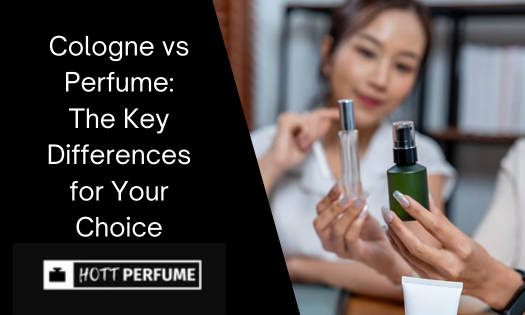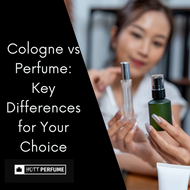Cologne vs Perfume: Key Differences for Your Choice
Posted by Tina Wilson on Sep 3rd 2025

Introduction to Fragrance
The word “fragrance” comes from “fragrant,” which means a pleasant, sweet smell. Fragrances are commonly divided into types such as eau de parfum, eau de toilette, and cologne. Knowing the differences between these types, including their oil concentration, helps you choose the right scent for your needs.
A key factor in these categories is fragrance concentration levels—the amount of fragrance oils and essential oils—which affects how strong and long-lasting a scent will be. The art of perfume-making has a rich history dating back to ancient civilizations, evolving over time to include various fragrance types that suit different preferences and occasions.
History of Perfume
The history of perfume stretches back to ancient civilizations, where early cultures developed unique fragrance traditions that have evolved over thousands of years. From the use of natural resins and oils in Egypt and Mesopotamia to the sophisticated perfume-making techniques of the Greeks and Romans, as well as other fragrance types perfume has held an important place in human society.
Throughout history, perfumes have been used not only for personal scent but also for religious ceremonies, social status, and medicinal purposes. Different cultures contributed to the art and science of fragrance, creating a rich tapestry of scents, including a sweet scent, and methods that continue to influence modern perfumery.
Understanding the history of perfume deepens our appreciation for its complexity and beauty, revealing how fragrance has played a significant role in human culture and daily life across the ages. This fascinating journey highlights the enduring allure and importance of fine fragrance and scent in our world.
Fragrance Oils and Concentration
Fragrance oils, especially those with lower fragrance concentration, are the essential ingredients that give perfumes their distinctive scents. The concentration of these oils in a product directly affects the strength, intensity, and longevity of the fragrance.
Perfumes are categorized based on the percentage of fragrance oils they contain. Higher concentrations mean a more potent and longer-lasting scent, while much lower fragrance concentration results in lighter, more subtle aromas. For example, eau de parfum typically contains a higher concentration of fragrance oils—usually between 15% and 20%—making it stronger and longer-lasting than eau de toilette, which generally has around 5% to 15% fragrance oils.
Cologne usually has an even lower concentration of fragrance oils, often between 2% and 5%, which makes it lighter and more refreshing but shorter-lived compared to perfumes. This difference in concentration is the main factor that distinguishes perfume vs cologne, with perfumes offering richer, more intense scents and colognes providing a gentler, more subtle fragrance experience.
Understanding these variations helps you choose the right fragrance type based on how strong and long-lasting you want your scent to be.
Eau De Toilette and Eau Fraiche
Eau de toilette is a type of fragrance that contains a moderate concentration of fragrance oils, typically between 5% and 15%. The name, a term eau de toilette, comes from the French phrase “faire sa toilette,” which means to get ready or freshen up. This makes eau de toilette a popular choice for those seeking a light yet noticeable scent that is suitable for everyday wear.
Eau fraiche, by contrast, has an even lower concentration of fragrance oils—usually around 1% to 3%. Because of its very light scent and even lower fragrance concentration, minimal use of alcohol, eau fraiche is often recommended for people with sensitive skin or those who prefer a very subtle fragrance.
Both eau de toilette and eau fraiche are favored for casual, daytime use. They offer a fresh, clean aroma that is gentle and refreshing, making them ideal for situations where a strong scent might be overwhelming. These types of fragrances provide a subtle but pleasant presence that complements everyday activities.
Eau De Cologne
Eau de cologne is a fragrance with a relatively low concentration of fragrance oils, usually between 2% and 5%. It is known for its fresh, citrusy aroma, often blended with herb and citrus notes that create a light and invigorating scent.
While traditionally popular among men, eau de cologne is a versatile fragrance suitable for anyone regardless of gender. Armani Code and Acqua di Gio are two iconic fragrances from Giorgio Armani. It is commonly chosen for casual, everyday wear due to its refreshing and subtle nature.
Eau de cologne is also appreciated for its affordability and versatility, making it an excellent option for those seeking a pleasant fragrance without a high price tag. Its lightness and ease of use make it a practical choice for daily use, especially in warmer weather or active lifestyles.
Discover the Best Cologne for Men
Extrait De Parfum
Extrait de parfum, also known simply as parfum or pure perfume, represents the highest concentration of fragrance oils available in a perfume product, typically exceeding 20%. This highest fragrance concentration results in a rich, intense aroma that is both powerful and long-lasting, often remaining noticeable on the skin for 6 to 8 hours or more, depending on the formulation and individual skin chemistry.
Because of its potency, extrait de parfum is usually applied sparingly—just a small amount on pulse points such as the wrists, neck, or behind the ears is enough to provide a lasting scent experience. This makes it an excellent choice for special occasions, evening events, or any time you want your fragrance to make a strong, memorable impression.
Extrait de parfum is often regarded as a luxury item due to the high quality and quantity of fragrance oils used, which also contributes to its higher price point compared to lighter fragrance types like eau de toilette or eau de cologne. The richness of extrait de parfum allows for a more complex and nuanced scent profile, with multiple layers of notes that evolve over time, revealing different facets of the fragrance as it wears.
Perfume connoisseurs and enthusiasts particularly appreciate extrait de parfum for its depth, sophistication, and the artistry involved in its creation. Understanding fragrance working offers a sensory experience that is both elegant and enduring, making it a prized addition to any fragrance collection.
Fragrance Notes
Fragrance notes are the individual scents that combine to create the overall aroma of a perfume. They are typically divided into three layers: top notes, middle notes, and base notes, each playing a distinct role in the fragrance's development, particularly those with an alcohol base.
Top notes are the first scents you perceive immediately after applying a perfume. They are usually light, fresh, and volatile, designed to create an initial impression. Common top notes include citrus, herbs, and light fruits.
Middle notes, also known as heart notes, emerge after the top notes fade, usually within a few minutes. These form the core of the fragrance and often include floral, spicy, or fruity scents that add depth and character.
Base notes are the longest-lasting part of the fragrance, providing richness and intensity. They appear once the middle notes begin to dissipate and can linger for hours. Typical base notes include woods, musk, amber, and vanilla.
Understanding these layers helps you appreciate the complexity and evolution of a perfume over time. Additionally, fragrance notes are grouped into families such as floral, citrus, woody, oriental, and fresh, each offering unique scent profiles that cater to different preferences and occasions.
Base Notes
Base notes form the foundation of a perfume, delivering a rich, deep aroma that lingers for several hours after the initial application. These notes provide depth, warmth, and lasting power to the fragrance, often emerging once the lighter top and middle notes have faded.
Common base notes include fragrance oils like vanilla, amber, and musk, which contribute to the scent’s complexity and sensuality. Base notes are typically grouped into families such as woody (e.g., sandalwood, cedar), oriental (e.g., spices, resins), and gourmand (e.g., sweet, edible-like scents such as caramel or chocolate), each offering distinct characteristics.
The selection of base notes depends on personal taste and the desired overall scent profile, as well as how long the fragrance is intended to last. Because base notes shape the perfume’s final impression and longevity, they are a crucial element in fragrance design and play a key role in defining the perfume’s unique character.
The Top 5 Popular Perfume Notes You Need to Know
Fragrance Types and Usage
Different types of fragrances are designed to suit various occasions and preferences, making it important to choose the right one for your needs.
Eau de toilette and eau fraiche are popular for casual, daytime wear due to their lighter scent and lower concentration of fragrance oils. They offer a fresh, subtle aroma that is perfect for everyday use.
On the other hand, eau de parfum and extrait de parfum have higher concentrations of fragrance oils, resulting in richer, longer-lasting scents. These types are often reserved for special occasions or evening events when a more intense fragrance is desired.
Fragrances can also be categorized by their scent profiles—such as floral, citrus, woody, or oriental—helping you find a scent that matches your personal taste and the mood you want to convey.
Ultimately, the choice of fragrance type depends on your preferences, the occasion, and how long you want the scent to last. Understanding these differences allows you to appreciate the complexity of perfumes and select the perfect fragrance for every moment.
Longevity and Strength
The longevity and strength of a fragrance are primarily influenced by its concentration of fragrance oils and the type of fragrance. Higher concentrations, such as those found in eau de parfum and extrait de parfum, typically result in scents that last longer and have a more intense presence compared to lighter options like eau de toilette or eau de cologne.
Choosing the right fragrance depends on your personal preferences, including how strong you want the scent to be and how long you want it to last throughout the day. Understanding these factors helps you make an informed decision and find a fragrance that fits your lifestyle and occasions.
Longevity and strength are key elements in the overall fragrance experience, determining both the duration and intensity of the scent you wear.
Perfume Ingredients
Perfume ingredients form the building blocks of every fragrance, shaping its unique scent and character. Knowing about these ingredients helps you appreciate the complexity and artistry behind each perfume.
-
Fragrance Oils: Concentrated oils that carry the main scent of a perfume, providing richness and depth.
-
Essential Oils: Natural oils extracted from plants, flowers, and fruits, offering authentic and often complex aromas.
-
Aroma Compounds: Chemical substances, either natural or synthetic, used to create specific scents or enhance fragrance stability.
-
Natural Ingredients: Derived from plants, flowers, woods, and resins, these ingredients add authenticity and complexity to perfumes.
-
Synthetic Ingredients: Man-made compounds designed to replicate natural scents or create entirely new aromas, often improving longevity and consistency.
-
Blended Formulations: Many perfumes combine natural and synthetic ingredients to balance scent quality, durability, and cost.
-
Fixatives: Ingredients that help stabilize the fragrance and extend its lasting power on the skin.
The selection of perfume ingredients depends on the desired scent profile, longevity, and personal preference, making each fragrance a unique blend of art and science.
Conclusion
Understanding the differences between perfume vs cologne, along with the various fragrance types, concentrations, and ingredients, is essential for choosing the perfect scent that suits your personality, lifestyle, and occasions. From the light and refreshing notes of eau de cologne and eau de toilette to the rich, long-lasting aromas of extrait de parfum, each fragrance type offers a unique experience in strength, longevity, and complexity.
By learning about fragrance notes—top, middle, and base—and how they unfold over time, you can better appreciate the artistry behind every perfume. Additionally, knowing the role of natural and synthetic ingredients, as well as fixatives, helps you understand how perfumes achieve their distinctive scents and lasting power.
Ultimately, selecting the right fragrance is a personal journey that combines knowledge, experimentation, and preference. With this understanding, you can confidently explore and find a signature scent that not only enhances your presence but also expresses your individuality and style, and score the best deals on your favorite perfumes, by checking independent reviews.


